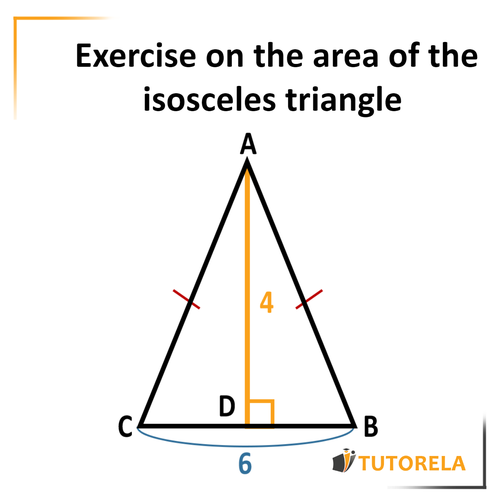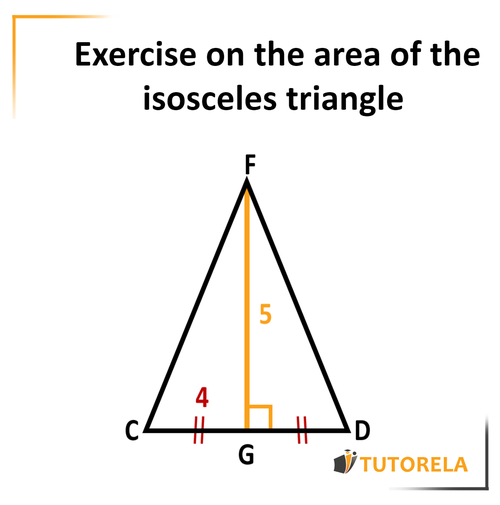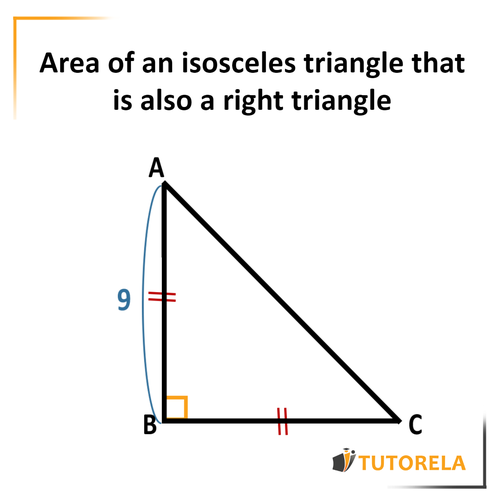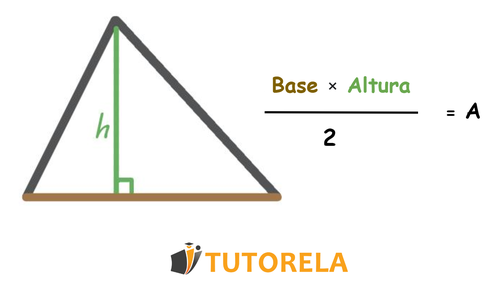
2Height of the base × Base=A
The triangle ABC is given below.
AC = 10 cm
AD = 3 cm
BC = 11.6 cm
What is the area of the triangle?
Calculating the area of an isosceles triangle is very simple, easy, and even identical to the calculation we do to find out the area of other types of triangles. Therefore, if you happen to get a question about calculating the area of isosceles triangles on the exam, I assure you that a small smile will appear on your face.
We will multiply the base by the height and divide by two.

Remember!
The main property of the isosceles triangle is that the median of the base, the bisector, and the height are the same, that is, they coincide. Therefore, even if the question only names the median of the base or the bisector, you can immediately deduce that it is also the height of the triangle and use it to calculate its area.
Observe the theorem holds true only with the height, the median of the base, and the bisector!
You didn't think we were going to send you off without any exercises on the topic, did you? Time to practice!
What is the area of the given triangle?
What is the area of the triangle in the drawing?
Calculate the area of the triangle ABC using the data in the figure.
Here you have an isosceles triangle

Given that:
-
Height
What is the area of the triangle?
Solution: We will proceed according to the formula - the height
multiply by the base
and divide the received product by
We will obtain:
The area of the triangle is cm2.
You have the isosceles triangle

Given that:
The median of the base
Calculate the area
Solution: Let's remember that, in an isosceles triangle, the median of the base is also the height, therefore, we can use it in the formula for the area of the isosceles triangle. Let's note: Height
Now let's see that we have only half of the base .
Since is given as the median, we can deduce that also and consequently, the entire side of the base
Now let's put it in the formula:
The area of the triangle is cm2 .
Calculate the area of the right triangle below:
Triangle ABC is shown below.
BC is equal to 5 cm.
Side AD is equal to 4 cm.
Is it possible to calculate the area of the triangle? If so, what is it?
Calculate the area of the following triangle:
Formula to calculate the area of an isosceles triangle that is also a right triangle:
If you come across calculating the area of an isosceles triangle whose height has not been given, but you know it is a right triangle, it is useful to know the following trick:

Let's see how it is done by applying it in an exercise: Before you, you have an isosceles right triangle
Given that
angle
Calculate the area of the triangle
Solution: Let's not be scared of not having data about the height and proceed according to the formula: the triangle is isosceles, therefore .
These are the two legs of the triangle - they form a right angle. Consequently, we will obtain:
The area of the triangle is cm2 .
The triangle ABC is given below.
AC = 10 cm
AD = 3 cm
BC = 11.6 cm
What is the area of the triangle?
The triangle we are looking at is the large triangle - ABC
The triangle is formed by three sides AB, BC, and CA.
Now let's remember what we need for the calculation of a triangular area:
(side x the height that descends from the side)/2
Therefore, the first thing we must find is a suitable height and side.
We are given the side AC, but there is no descending height, so it is not useful to us.
The side AB is not given,
And so we are left with the side BC, which is given.
From the side BC descends the height AD (the two form a 90-degree angle).
It can be argued that BC is also a height, but if we delve deeper it seems that CD can be a height in the triangle ADC,
and BD is a height in the triangle ADB (both are the sides of a right triangle, therefore they are the height and the side).
As we do not know if the triangle is isosceles or not, it is also not possible to know if CD=DB, or what their ratio is, and this theory fails.
Let's remember again the formula for triangular area and replace the data we have in the formula:
(side* the height that descends from the side)/2
Now we replace the existing data in this formula:
17.4
What is the area of the given triangle?
This question is a bit confusing. We need start by identifying which parts of the data are relevant to us.
Remember the formula for the area of a triangle:
 The height is a straight line that comes out of an angle and forms a right angle with the opposite side.
The height is a straight line that comes out of an angle and forms a right angle with the opposite side.
In the drawing we have a height of 6.
It goes down to the opposite side whose length is 5.
And therefore, these are the data points that we will use.
We replace in the formula:
15
What is the area of the triangle in the drawing?
First, we will identify the data points we need to be able to find the area of the triangle.
the formula for the area of the triangle: height*opposite side / 2
Since it is a right triangle, we know that the straight sides are actually also the heights between each other, that is, the side that measures 5 and the side that measures 7.
We multiply the legs and divide by 2
17.5
Calculate the area of the triangle ABC using the data in the figure.
First, let's remember the formula for the area of a triangle:
(the side * the height that descends to the side) /2
In the question, we have three pieces of data, but one of them is redundant!
We only have one height, the line that forms a 90-degree angle - AD,
The side to which the height descends is CB,
Therefore, we can use them in our calculation:
36 cm²
Calculate the area of the right triangle below:
Due to the fact that AB is perpendicular to BC and forms a 90-degree angle,
it can be argued that AB is the height of the triangle.
Hence we can calculate the area as follows:
24 cm²
Calculate the area of the following triangle:
Calculate the area of the following triangle:
Calculate the area of the following triangle: